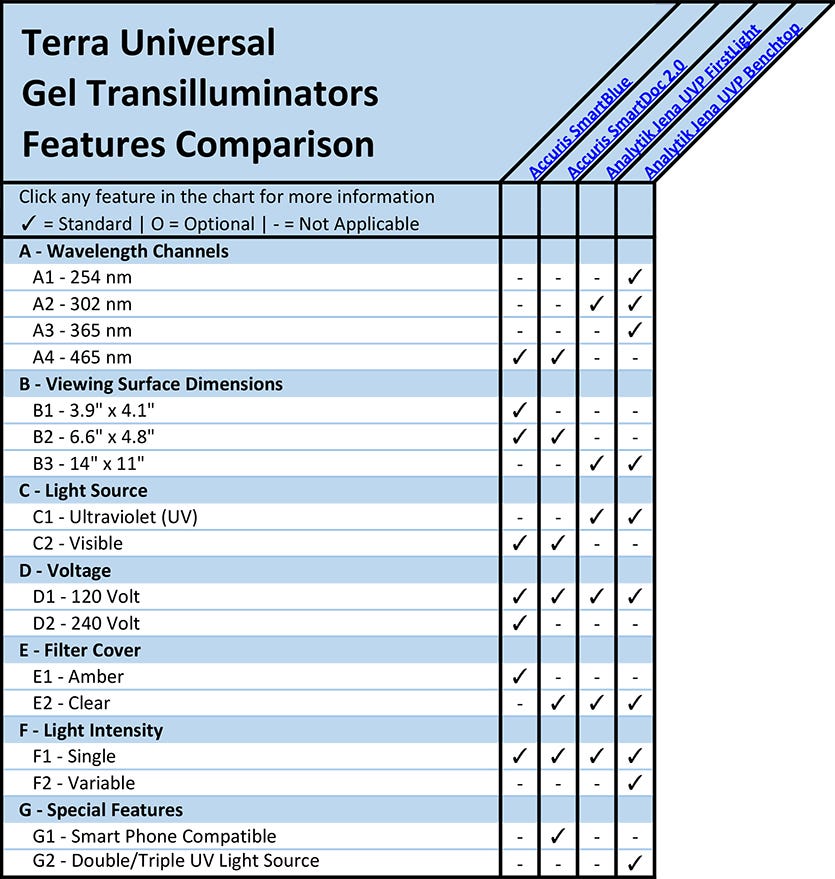
Lab Transilluminator Features Comparison

Laboratory transilluminators,or gel light boxes, are used by life science labs to visualize DNA, RNA or protein samples separated through gel electrophoresis.
What is a Lab Transilluminator?
Lab transilluminators contain an ultraviolet (UV) or visible (blue or white) light source, glass viewing surface, UV-blocking or amber filter cover.
How Does a Lab Transilluminator Work?
The transilluminator emits UV or visible light at a specified wavelength onto the glass viewing surface (where the agarose or polyacrylamide gel is placed). Transilluminators may be used as stand-alone systems or in conjunction with gel documentation imagers.
What Is a Lab Transilluminator Used For?
Common in molecular biology, genomics, microbiology and drug development labs, transilluminators support PCR segment identification, DNA quantification and sample purification after restriction enzyme digestion.
A - Transilluminator Wavelength Channels
(back to chart)
Gel transilluminators emit ultraviolet light (254 nm, 302 nm and 365 nm) or visible light (465 nm) for visualization of fluorescent nucleic acid or protein samples. The UV or visible light wavelength emitted by the transilluminator must match the absorbance spectrum of the fluorescent dye used during gel separation.
Blue light, emitted at 465 nanometers, is optimal for viewing samples stained with commercial dyes such as SYBR Green, SYBR Gold or GFP.
UV Visualization Wavelength Channels
254 nanometer light is optimal for DNA cross-linking, 302 nanometer light is ideal for short exposure gels stained with Ethidium Bromide, and 365 nanometer light is best for gel band cutting.
B - Viewing Surface Dimensions
(back to chart)
The Accuris Smart BlueCompact is a small footprint transilluminator with a 4” square viewing surface to save on benchtop space. Larger-footprint transilluminators, like UVP’s FirstLight, include a 14” x 11” viewing surface to visualize multiple gels during a single run.
C - Light Source
(back to chart)
C1 - Ultraviolet (UV) Light Transilluminators
UV transilluminators include a 254 nm, 302 nm or 365 nm light excitation source for quantitative fluorescent imaging of DNA, RNA or protein samples.The backlit, 25-watt UV lamp emits high-output illumination for uniformity across the imaging surface and accurate gel-to-gel comparisons.
Blue Light vs UV Illumination - Pros & Cons
While UV illumination results in more precise imaging of gel bands than visual blue light, UV light carries a higher risk of sample damage (due to over-exposure) and worker injury. All operators using UV transilluminators must wear UV face shields and use UV-blocking surface covers while the unit is operating.
C2 - Visible Light Transilluminators
Light Transilluminators forNucleic Acid and Protein Gel Visualization
Visible light transilluminators include an 8-watt bulb emitting blue light at 465 nanometers for visualization of nucleic acid or protein gels containing SYBR Green, SYBR Safe or GFP fluorescent dyes.
Visible Light vs UV Light Illuminator Differences
While visible light models demonstrate reduced uniformity and band clarity as compared to UV systems, they carry no risk of sample damage or operator exposure. Although visible light transilluminators represent an economical alternative to UV systems, they are less effective in visualizing Ethidium Bromide gels and performing accurate gel-to-gel comparisons.
D - Transilluminator Voltage
(back to chart)
120-volt connections are suitable for standard laboratory power outlets in the United States.
208-volt or 240-volt connections, common in mainland Europe, require less current (amperage) and smaller conductors than equipment designed to operate at 120-volt.
E - Transilluminator Filter Cover
(back to chart)
E1 - Amber For Visible Light Transilluminators
Amber filter covers block blue light transmission to ensure high-quality, precise imaging of fluorescent dyes with emission wavelengths above 500 nm.
E2 - Clear, UV-Blocking For UV Transilluminators
Clear, UV-blocking filters prevent operator exposure while supporting sample visualization. UV blocking filters easily adjust for loading and unloading of gels.
F - Transilluminator Light Intensity
(back to chart)
F1 - Single Intensity Transilluminators
Single-light transilluminators are ideal for low-throughput research settings involving gel staining with a single fluorescent dye.
F2 - Variable Intensity Transilluminators
Variable light intensity transilluminators include low, medium and high settings for different applications. The low-intensity mode is optimal for gel positioning, multiple band excision, and sample imaging. The medium intensity mode is ideal for single-band excision. The high-intensity mode is best for low sample concentrations.
G - Special Transilluminator Features
(back to chart)
G1 - Smart Phone Compatibility
The Accuris SmartDoc 2.0 system is compatible with smartphones and tablets to support the imaging of fluorescent gel stains. Each model includes an orange imaging filter to enhance sample clarity.
G2 - Double or Triple UV Light Transilluminator Sources
Analytik Jena’s UVP Benchtop Transilluminators include optional double or triple UV lamps for light emission at up to three separate, concurrent wavelengths: 254 nm, 302 nm, and 365 nm.
Laboratory-Equipment.com is a specialty division of Terra Universal. For nearly 40 years, Terra Universal has served the life science, pharmaceutical, biotechnology, and medical device markets. Customers appreciate a worldwide network of reps, factory-direct support, and ready-to-ship items available from Terra's manufacturing and warehouse facilities in Fullerton, California.
Shop a wide selection of UV and visible light illuminators online for a wide variety of applications including general laboratory, research, PCR, DNA/RNA techniques, ELISA, protein analysis, and cell culture.
Contact a Laboratory-equipment.com specialist through web chat, email, or phone for pricing or a same-day quote.
Shop Lab Illuminators by Model
Terra Universal is the leading expert in the design and fabrication of ISO rated cleanrooms, furnishing and supplies.
Get a free consultation from one of our cleanroom specialists:
Call (714) 459-0731


